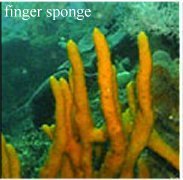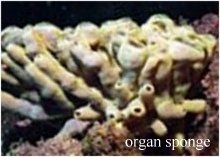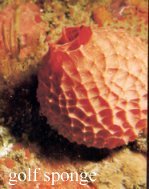 Sponges are mainly found in the oceans throughout the world, however there are a few freshwater species.
They are more abundant in tropical waters, where they and other invertebrates such as corals are important in the formation of reefs. They also can be found attatched to rocks, coral, boats, shells, wharves, and oilrigs. In fact just about anything you can think of.
Sponges are mainly found in the oceans throughout the world, however there are a few freshwater species.
They are more abundant in tropical waters, where they and other invertebrates such as corals are important in the formation of reefs. They also can be found attatched to rocks, coral, boats, shells, wharves, and oilrigs. In fact just about anything you can think of.
They are found more so in shallower waters of the continental shelf.
Sponges are filter feeders and their single purpose in life is to pass water through itself straining off bacteria and fine debris from the water, the water yielding food and oxygen, minerals, and carrying away waste products.
Around our coasts you might discover a few sponges, some are found in the shallows, some in slightly deeper waters and some might be washed up on our beaches.
Below are a few of the more common sponges.
1. LONG FINGER SPONGE: Cast ashore very frequently off some of the Auckland and Northland East Coast beaches. Usually up to 60cm (2ft)in length and over 30cm (1ft)in width are not uncommon. The skeletal mass is of light yellowish brown colour. The living colonies occur attached to rock below the lowest tidal level.
2. ORGAN PIPE SPONGE: Found on reefs around the coasts. It grows in the form of delicate thin walled tubes of up to 30cm (1ft) in length and 25cm (1in) or more in diameter. These tubes grow in erect position on the sea bed..
3. GLOBE SPONGE: These sponges are a brilliant orange in colour and look very much like a large golf ball. It is common in the lower Inter tidal rocky zone attached to the undersides of boulders and to the roofs of caves.
4. CUP SPONGE: These sponges are normally seen in deeper waters up to 70 metres (240ft).
The sponge feeds by moving water into lateral incoming pores and then out through a large opening at its top. These cells line either small or large chambers, and are connected by canals, and the entire sponge can build up pressure and shoot water long distances.
Construction of sponges consists of an outer layer body wall containing cells and an inner layer of runner like branched cells that move water through the animals.
Most have a skeleton of spongin, elastic.
Sponges are living cells and are sometimes accommodation to a large number of algae and fish such as shrimps and some worms.

They are eaten by turtles, sea slugs (nudibranches) sea stars and a few fish.
Some sponges are toxic.
Sponges come in lots of beautiful colours, (orange, yellow, green, purple, violet and scarlet) to name a few. Also different shapes and sizes depending where they are for instance in strong currents they may be short flat or round, and in calmer waters they will branch out like a tree.
They can be found as small as 1 or 2 cm to as large as 6.5'. The larger ones tend to found in deeper water.
There are six species of sponge that are considered for commercial use. The skeletons of these sponges are composed of a flexible protein material called sponging. The sponges found in the Mediterranean and Red Sea are said to be the best in the world.
These sponges are gathered by divers and are left to decompose. The remaining undecomposed skeleton fibers are then washed, bleached, sometimes dyed, and cut into the familiar blocks seen in shops.


To reproduce eggs and sperm unite to produce a free-swimming larva that settles on a new surface and develops into a new sponge.
The sperm is shed into the water but the eggs stay in the sponge and is fertilized there. This is called spawning. A larva may be produced, this larve then swims for a few days then settle changing into colonies. Reproduction can also occur by small, internal buds, each one able to give rise to a new sponge.